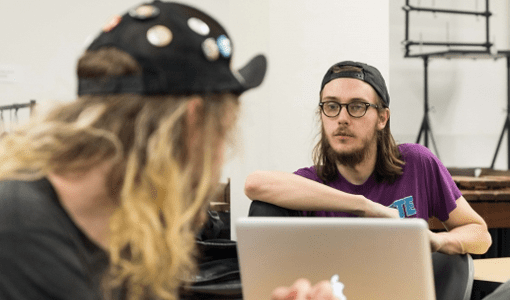
Thinking outside the box is getting to be a clichéd idea. So Jonathon Keats is challenging students to think outside of the galaxy.
Keats, UNC Asheville’s Black Mountain College Legacy Fellow for the spring 2018 semester, engaged students to design and build very original “instruments,” and perform in Lipinsky Auditorium, with a goal of reaching beyond their human audience and deep into the cosmos.
“We didn’t quite get to the level of communicating with other galaxies, but we re-examined our own ways of communicating and also the ways that other living creatures on this planet – being the one we’re most familiar with – use to communicate and sustain life,” said Michelle Troszak, a junior studying music at UNC Asheville.

Mary Steinbrecher (left) and Michelle Troszak (photo by Emmanuel Figaro ’18)
Troszak is a student in Keats’ class, Music Experimentation, co-taught with music faculty members Bill Bares and Wayne Kirby. Keats has challenged students to think “Copernican” – to abandon the self-centered concept of existence that placed Earth at the center of the cosmos with every star and planet rotating around it. And to embody that concept, Keats has developed “instruments” that generate gamma rays, gravitational waves and other forms of vibration that humans may not perceive as music (or perceive at all) but that may perhaps be detectable to distant life forms.
Is Keats’ audience really light years away? Or is he more focused on the earthlings attending his concert in Lipinsky Auditorium and his students? Keats concedes only that all his projects are aimed at “multiple audiences,” and that universities are a great fit for his approach.
“We become more habituated to rote ways of thinking as we get on in life,” said Keats. “The curiosity that you find in students is crucial for society, and by nurturing that through projects that are about larger and more open-ended explorations of ourselves, our society and the universe, that is a way to build a practice within the lives of students that may last long beyond their university experience.”
Creating vibrations imperceptible to human ears may seem an odd fit for a music course, but according to music major Mary Steinbrecher, some of Keats’ concepts intersect with music theory, harmonics and sonic phenomena. “Some of the concepts haven’t been ‘super out there,’ but some of them, well, yes.”
Steinbrecher collaborated with Troszak on a terrestrially-focused, but still boundary-crossing performance using metal plates connected to a synthesizer. “You have to close the circuit by interaction with other people, so it’s in a tiny way Copernican because you have to connect with others to create sound,” said Steinbrecher.
“I came here thinking about a Copernican orchestra and what it might mean to challenge students to make instruments and compositions that are in some way Copernican – not only in our own hearing range or our own cognitive system. And to some extent that has been borne out,” said Keats.

Dylan Metz (facing) with a classmate (photo by Emmanuel Figaro ’18)
And some students, like new media major Dylan Metz, applied Keats’ concept while working within the human sensory and cognitive range. “It’s a really original idea,” Metz said of Keats’ challenge, “and it’s interesting because it’s based on Copernicus and a really ancient idea. I’m doing a piece that features triggered playback of sampled cricket chirps and it’s been chopped up and looped so it’s in 7/8 time and establishes a rhythmic form.” Metz originally planned to have “one live cricket that will be a soloist of sorts, improvising on top of the human-created form,” but in rehearsal, the captive cricket remained silent. So Metz will instead pipe his music outside and incorporate live natural sound, including the chirps of any nearby insects.
“What’s interesting is that he’s managed to think about Copernicanism in a completely different way,” said Keats about Metz’ cricket composition. “What happens if we create an equal playing ground where a human and a cricket perform together and the degree to which the human intelligence and non-human intelligence are contributing is ambiguous? There are slippages in what we accept to be music and what we accept to be sentience or intelligence. Right now we are in a state of intolerance toward each other on every level … So this is a rather radical act, laying claim to a larger commonality … especially on a planet that is increasingly in peril of environmental conditions … that is suggestive of a larger, if not equality, totality of which we are a part.”
To learn more about the April 19 Lipinsky Hall concert and an April 20 follow-up discussion with Keats, Bares and Kirby, see the news release.